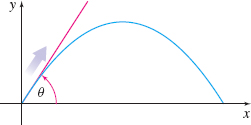EXAMPLE 5Application: Projectile Motion
An object is propelled from ground level at an angle θ, 0<θ<π2, to the horizontal with an initial velocity of 16feet/second, as shown in Figure 43. The equations of the horizontal position x=x(θ) and the vertical position y=y(θ) of the object after t seconds are given by x=x(θ)=(16cosθ)tandy=y(θ)=−16t2+(16sinθ)t
For a fixed time t:
- (a) Find lim and \lim\limits_{\theta \rightarrow 0^{+}}y(\theta).
- (b) Are the limits found in (a) consistent with what is expected physically?
- (c) Find \lim\limits_{\theta \rightarrow \frac{\pi}{2}^{-}}x(\theta) and \lim\limits_{\theta \rightarrow \frac{\pi}{2}^{-}}y(\theta).
- (d) Are the limits found in (c) consistent with what is expected physically?
Solution (a) \begin{eqnarray*} \lim\limits_{\theta \rightarrow 0^{+}}x(\theta) &=&\Big[\lim\limits_{\theta \rightarrow 0^{+}}(16\cos \theta)\Big] t = 16t\qquad{\color{#0066A7}{\hbox{$t$ fixed}}}\\[3pt] \lim\limits_{\theta \rightarrow 0^{+}}y(\theta) &=&\lim\limits_{\theta \rightarrow 0^{+}} [ -16t^{2}+(16\sin \theta) t ]\\[3pt] &=&\lim\limits_{\theta \rightarrow 0^{+}}(-16t^{2}) +\Big[\lim\limits_{\theta \rightarrow 0^{+}}(16\sin \theta)\Big] t = -16t^{2} \end{eqnarray*}
(b) The limits in (a) tell us that the horizontal position x of the object moves to the right (x = 16t) over time and that the vertical position y of the object immediately moves downward (y = -16t^{2}) into the ground. Neither of these conclusions is consistent with what we expect from the motion of an object propelled at an angle close to \theta = 0.
(c) \begin{eqnarray*} \lim\limits_{\theta \rightarrow \frac{\pi}{2}^{-}}x(\theta) &=&\Big[\lim\limits_{\theta \rightarrow \frac{\pi}{2}^{-}}(16\cos \theta)\Big] t = 0\\[3pt] \lim\limits_{\theta \rightarrow \frac{\pi}{2}^{-}}y(\theta) &=&\lim\limits_{\theta \rightarrow \frac{\pi}{2}^{-}}\left[ -16t^{2}+(16\sin \theta) t\right] = \lim\limits_{\theta \rightarrow \frac{\pi}{2}^{-}}(-16t^{2}) +\Big[\lim\limits_{\theta \rightarrow \frac{\pi}{2}^{-}}(16\sin \theta)\Big] t\\[3pt] &=&-16t^{2}+16t \end{eqnarray*}
(d) The limits we found in (c) tell us that the horizontal position remains at 0. The vertical position y = -16t^{2}+16t = -16t(t-1) tells us the object has a maximum height of 4feet and returns to the ground after 1 second. (The parabola y = -16t^{2}+16t opens down and has a maximum value at t = \dfrac{-b}{2a} = \dfrac{-16}{-32} = \dfrac{1}{2} at which time y = 4.) These conclusions are consistent with what we would expect from the motion of an object propelled close to the vertical.


